In an age where digital technologies and data science are advancing at a breakneck pace, our ability to visualize and interpret human psychological states is expanding like never before. Traditional psychological models and analysis methods, once primarily focused on qualitative interpretation, are now grappling with the need to incorporate quantitative data and its visual representation. Among the most promising avenues in this regard is the use of color models to reflect psychological traits and states.
The dual model for assessing psychological states, which classifies attitudes towards certain psychological criteria on a scale from -1 to +1, serves as a powerful tool for analyzing the human psyche. However, its application within existing visualization methods faces limitations due to the need for more vivid and intuitive representation of analysis results.
The RGB color model, employed across various fields from digital graphics to the theory of light perception, offers unique opportunities for visualizing complex data, including psychological assessments. The three-dimensional RGB space, with its capability to display a wide spectrum of colors, could form the basis for a new methodology in analyzing and interpreting psychological data.
This article aims to develop and justify a model that would transfer the dual model of psychological state assessments into the three-dimensional RGB space. This model suggests that balanced states of the points X, Y, Z could produce warm colors, while imbalanced states could result in cool colors. Additionally, it is proposed that balanced personality states might be visualized with natural colors, whereas imbalanced states could appear in acidic or bright colors. We will offer a logical connection explaining how values from the dual model ranging from -1 to +1 can be transformed into RGB color values from 0 to 255, providing a new tool for deep psychological analysis and self-discovery.
From black to white in RGB-model EGO-AI
RGB (Red, Green, Blue) is an additive color model used in electronic display systems like computer monitors and TVs to reproduce a wide range of colors. It’s based on the properties of light and how the human eye perceives it. In additive color models, colors are created by mixing different amounts of red, green, and blue light.
Here’s how RGB settings transition from the black to the white spectrum in the additive color model:
- Black in the RGB model represents the absence of light, which is (0, 0, 0) in RGB values—meaning no red, green, or blue light.
- Adding light: As light is added to the system, colors start to change. Increasing the intensity of red, green, and blue light alters the color. For instance, the maximum red light value (255, 0, 0) results in a vibrant red.
- Mixing primary colors: Combining two primary colors of light in equal parts creates secondary colors—cyan (0, 255, 255), magenta (255, 0, 255), and yellow (255, 255, 0).
- White represents a combination of all three primary light colors at maximum intensity (255, 255, 255), suggesting that red, green, and blue light mix to create an impression of white, uniting the entire visible spectrum. In the RGB model, white symbolizes the complete presence of light.
This process of additive color mixing, transitioning from complete absence of light (black) to full presence (white), illustrates how changes in RGB settings can reflect different light properties. It’s important to note that color perception also depends on physiological and psychological factors, making it a fascinating subject for study in various fields, including psychology and art.
Using RGB 3D model in psychological diagnostics
The RGB additive color model can be used in psychology to create a unique three-dimensional model that reflects an individual’s emotional state, psychological attitudes, and the dynamics of changes in their conscious and unconscious processes. This allows for visualizing and interpreting complex psychological concepts through color metaphors, making it easier to understand and analyze mental states. Let’s look at how this mechanism can be applied:
Modeling the Emotional Spectrum:
- RGB Axes as Emotional Axes: In the 3D RGB model, each axis (R, G, B) can be associated with a specific emotional or psychological dimension. For instance, the R (red) axis might represent levels of activity or aggression, G (green) for harmony or stability, and B (blue) for the depth of intuition or tranquility.
- Transitions from Negative to Positive: Negative and positive aspects of each dimension can be depicted by changing the intensity of the corresponding color from dark (minimal intensity, representing -1) to bright (maximum intensity, representing +1).
- 3D Space for Integration: The three-dimensional space allows for integrating these measurements, creating complex color compositions that reflect the unique combination of an individual’s conscious and unconscious attitudes. For example, a dominance of bright red and blue with green might indicate strong emotional excitement with elements of intuitive understanding but balanced with harmony.
Applications in Psychology:
- Therapy and Self-awareness: This model can be used therapeutically to visualize emotional states, helping clients better understand their internal conflicts and achievements. It can also serve as a tool for self-discovery, allowing individuals to observe the dynamics of their psychological development.
- Research: In academia, such a model can facilitate the study of relationships between different emotional and psychological measurements, offering a new method for data analysis.
- Education and Development: In educational and developmental programs, the RGB model can be used to teach mindfulness, emotional intelligence, and a better understanding of interpersonal relationships.
Using the RGB model in psychology opens up new perspectives for a deep understanding and analysis of the human psyche, allowing not just visualization but also quantitative assessment of emotional and psychological states. This approach can enrich the practice of psychotherapy, providing a vivid and intuitively understandable picture of a client’s emotional processes, and fostering self-reflection and personal growth.
Advantages:
- Clarity: Visualization allows for quick and effective communication of complex psychological concepts.
- Dynamics: The model can display changes over time, showing progress or regression in personal development.
- Individualization: Each emotional picture is unique, highlighting the individual nature of psychological processes.
- Integration: The model promotes a holistic perception of personality, integrating various aspects of the psyche.
Integrating the RGB additive color model into psychological research and practice opens new horizons for understanding oneself and others. This model offers a unique way to visualize and analyze emotional and psychological states, making them accessible for comprehension and discussion. Using color as the language of emotions and psychological processes can become a powerful tool in the hands of psychologists, therapists, researchers, and anyone seeking deep self-awareness and development.
EGO-AI
Illustrative examples of using the RGB model
Let’s take a practical example by considering an ego-code with a high level of discrepancy between the subject’s conscious desires and unconscious settings. Suppose after analysis, we obtained the following values:
- Conscious desire for activity and energy: high (positive value for red color R), R = 240.
- Unconscious drive for peace and stability: also high (positive value for blue color B), B = 240.
- Lack of harmony and balance: (low value for green color G, indicating imbalance), G = 30.
This code reflects an internal contradiction between the desire to be active and energetic (high R) and a simultaneous inclination towards peace and deep self-awareness (high B), while there’s a lack of balance (low G), indicating significant internal discord.
Visualization in RGB Settings Based on the values we have, we can create an image that reflects this emotional state of the subject:
- Red and blue colors will dominate, indicating strong but opposing tendencies in the subject’s psyche.
- The green color will be barely visible, symbolizing the lack of harmony and internal balance.
Let’s create a visualization using these RGB settings (240, 30, 240).
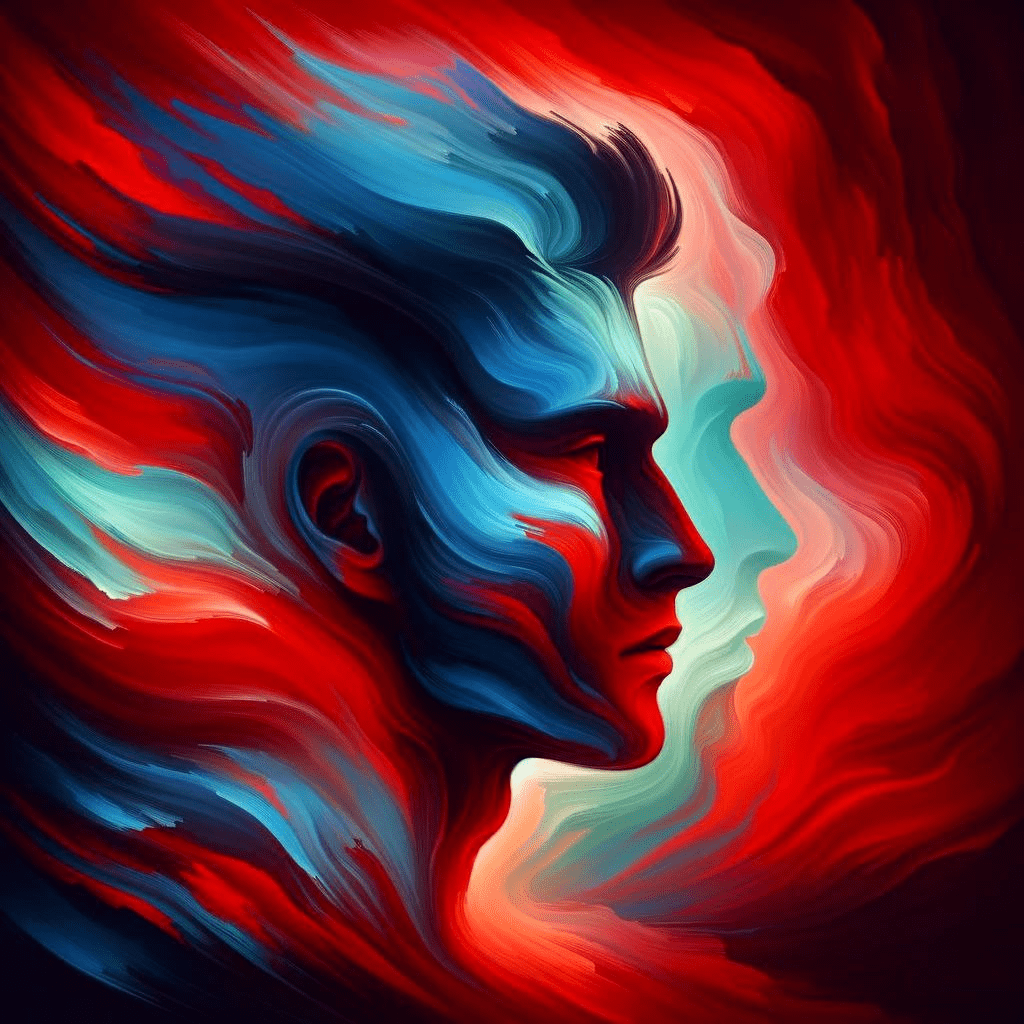
In the initial phase of psychological integration, often characterized by reevaluation or denial, individuals grapple with conflicting aspects of their psyche. This stage can be vividly represented in the RGB (Red, Green, Blue) model, aligning with the EGO-AI concept of emotional states corresponding to psychological criteria.
Reevaluation/Denial Phase in RGB Terms:
- Red Spectrum (R): This color often signifies emotional intensity, conflict, and active engagement with one’s shadow aspects (unacknowledged or rejected parts of oneself). During the reevaluation or denial phase, a higher intensity of red might indicate the individual’s confrontation with and denial of these shadow aspects. The struggle could be visualized as fluctuations in the red spectrum, where deeper shades reflect the person’s resistance to recognizing or accepting these parts.
- Green Spectrum (G): Symbolizing growth, balance, and harmony, the green spectrum in this phase may appear muted or disturbed, representing the individual’s challenge in achieving balance. The fluctuation between lighter and darker shades of green could depict the ongoing internal negotiations and the struggle to harmonize the conscious and unconscious realms.
- Blue Spectrum (B): Reflecting depth, intuition, and tranquility, the blue spectrum might be less prominent during this phase, symbolizing a temporary disconnection from one’s deeper intuition and inner peace. Flickers of blue could indicate moments of insight or the beginning of acceptance, but the overall muted blue tones suggest the individual’s primary engagement with conflict and denial.
Emotional States Reflected in RGB Settings:
- High Red (R) values represent the turmoil and passion of confronting denied aspects.
- Fluctuating Green (G) values indicate the struggle for balance and integration.
- Lower Blue (B) values suggest a momentary disconnection from deeper understanding and tranquility.
This RGB model offers a unique perspective on psychological processes, providing a vivid visual language to represent the dynamic interplay of emotional states during the complex journey of psychological integration.
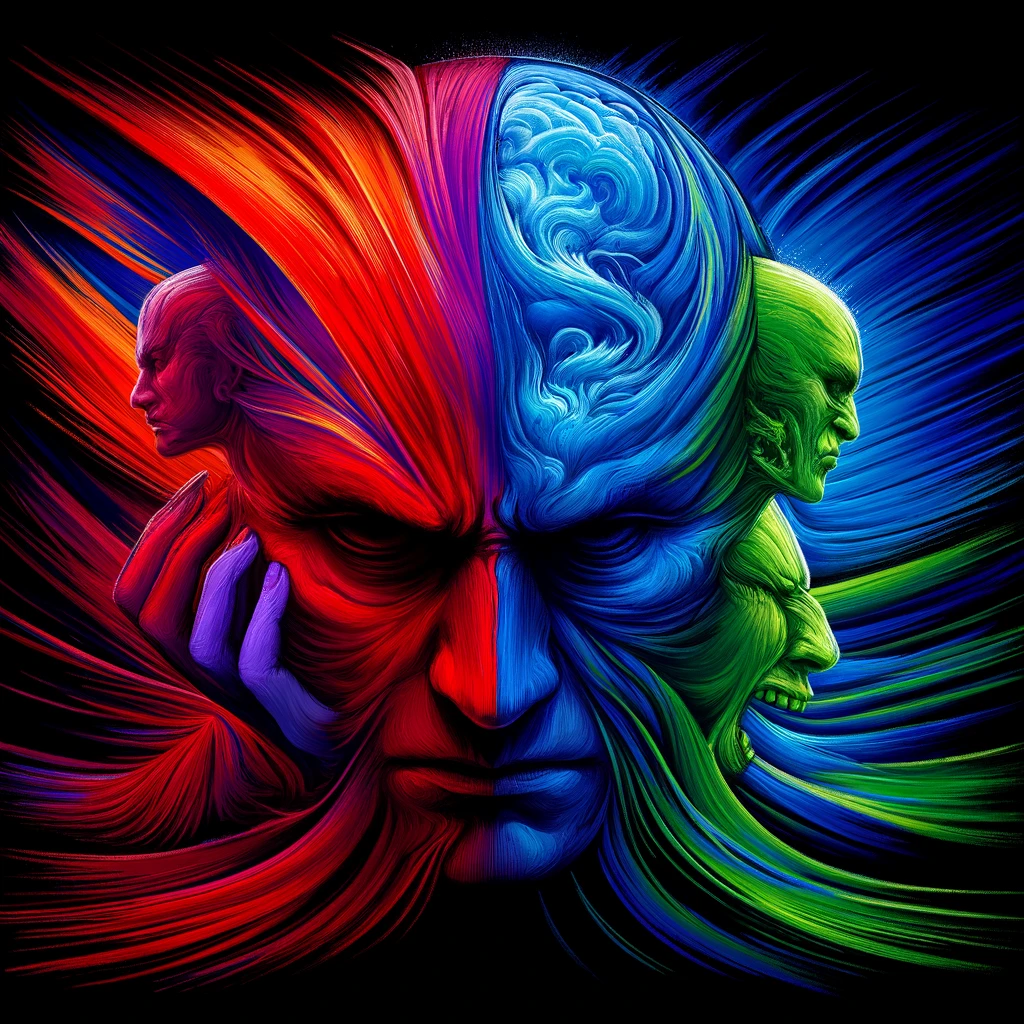
To illustrate the shift towards a more coordinated alignment in the context of psychological integration, let’s consider the logic behind changing RGB coordinates, which reflects improvements in internal balance and harmony. This process represents a transition from a high level of dissonance to a state where conscious and unconscious settings become more aligned.
Initial State:
- R (Red): High level, indicating activity, conflict, or tension.
- G (Green): Low level, symbolizing a lack of harmony and balance.
- B (Blue): High level, showing depth, intuition, or a need for tranquility.
Transition Process: As a person engages in psychological work and self-discovery, they begin to integrate conflicting aspects of their personality, reducing internal conflicts and establishing more harmonious relations between the conscious and unconscious.
Reducing Dissonance (R and B):
- R (Red): The level begins to decrease, reflecting a reduction in internal conflicts and tension.
- B (Blue): Also decreases, symbolizing a lesser need to escape reality for tranquility due to achieved inner harmony.
Increasing Harmony (G):
- G (Green): The level significantly increases, reflecting growth in harmony, balance, and adaptability.
Reflection in the RGB Model: These changes lead to a shift in coordinates towards a more balanced arrangement where no color dominates extremely, and the combination of all three creates calmer, balanced shades. An example of such a transition:
- R: Reduces to a moderate level (~120), reflecting reduced tension.
- G: Increases to a high level (~200), symbolizing growing harmony.
- B: Decreases to a moderate level (~120), indicating achieved inner harmony.
This transition to a more balanced configuration in the RGB model will visually manifest in a shift of shades in the image—from bright reds and blues to calmer, balanced colors, reflecting psychological evolution and integration of the personality.

In the next stage of integrating the three components according to the general logic of the EGO-AI RGB model, we move towards a more balanced and harmonious state. In this phase, emotional vectors representing activity (R), harmony (G), and intuition or tranquility (B) aim for a more uniform and integrated expression. This reflects a process where a person achieves deep self-understanding and acceptance, leading to a higher level of psychological maturity and wholeness.
RGB Color Settings for the Integration Stage:
- R (Red): Moves towards a moderate value, reflecting a reduction in conflict and an increase in energy directed towards constructive goals.
- G (Green): Significantly increases, symbolizing the achievement of internal balance, harmony, and the capacity to adapt and grow.
- B (Blue): Also moves towards a moderate value, indicating a deeper connection with the unconscious and enhanced intuitive awareness.
Example Settings:
- R: 180
- G: 220
- B: 180
These values symbolize the transition from black to white in a 3D color space, illustrating the move from fragmentation and conflict to harmony and integration. Visually, this can be represented as a smooth transition of colors, where there are no harsh contrasts but rather soft, balanced shades reflecting mental equilibrium and emotional stability.
Let’s create an EGO-NFT illustration that reflects this coherent state of mind with the specified RGB settings.
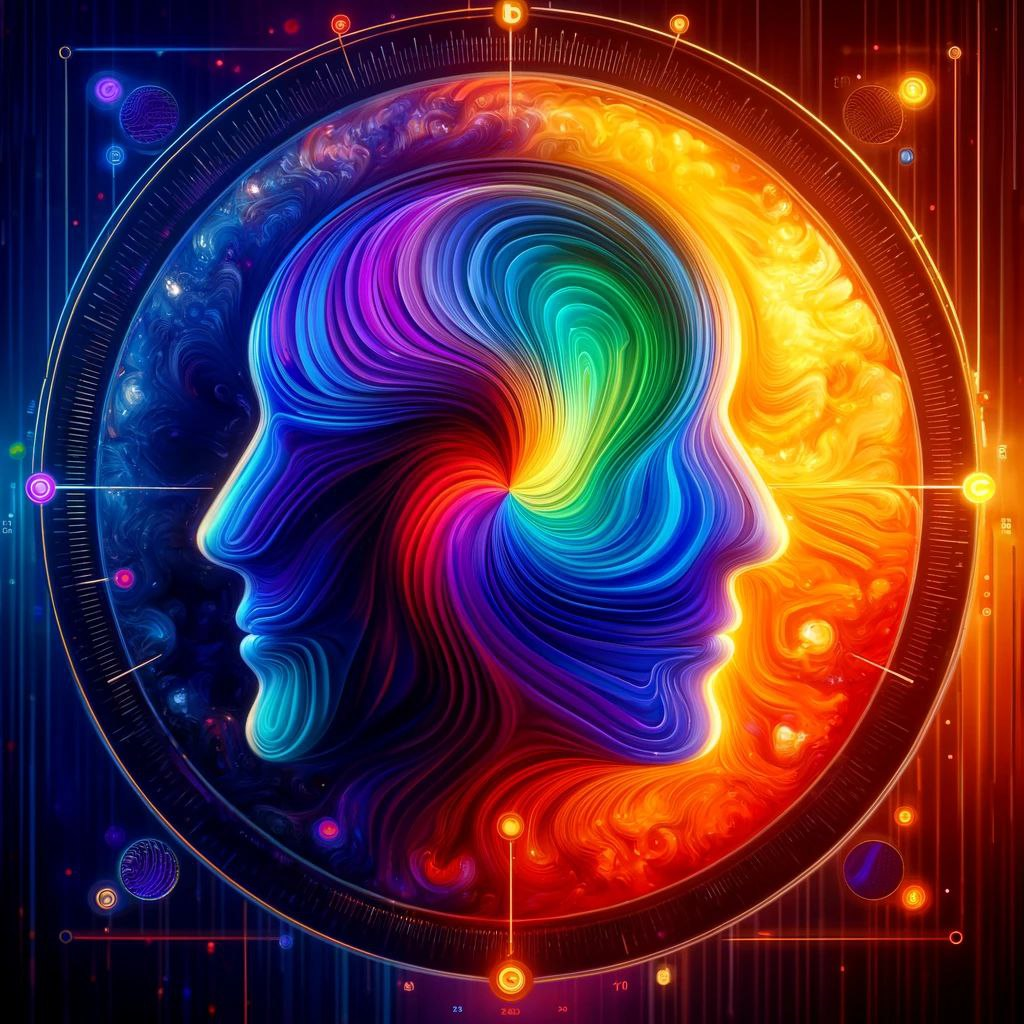
In the next stage of integration in the EGO-AI RGB model, which represents an even more advanced state of harmony and mental health, we aim to reflect the transition from dark to light tones, symbolizing the journey from the unconscious to the conscious, from disharmony to harmony. In terms of RGB, this can be envisioned as a gradual increase in the value of each color component from zero (black) to maximum (white).
Modeling Harmonic Colors:
- R (Red): Represents energy, passion, and action. At this stage, red transitions from aggressive energy to a softer and more manageable form, which might be represented by a value around 210.
- G (Green): Symbolizes growth, harmony, and stability. The value of green increases to about 230, reflecting deeper balance and integration.
- B (Blue): Embodies depth, intuition, and tranquility. Blue becomes even more pronounced, reaching a value around 220, indicating deep inner harmony and intuitive understanding.
Example RGB Settings for Illustration:
- R: 210
- G: 230
- B: 220
These settings create an image of a mental state on the path to complete integration and self-realization, reflecting the transition from struggle and disharmony to wholeness and harmony. The visualization of such a state will showcase warm and serene colors, symbolizing mental peace, inner strength, and deep self-understanding.
Let’s generate an illustration that reflects this state, with the specified RGB settings.

By integrating psychological age and CHARACTER values into the EGO-AI model with visualization settings along the XYZ axes and stylistic gradations, we can create a system that displays the depth and complexity of a person’s psychological development and their individual characteristics. Here’s how this can be implemented:
Psychological Age and Its Visualization:
- Early Age: Light and soft shades represent the initial phase of development. The theme and detailing of the image might be simpler and more playful, reflecting the openness and exploratory spirit of early age.
- Middle Age: Richer colors, including deep blues and greens, represent the depth of views and stability of personality. Images become more complex and multifaceted, reflecting the diversity of life experiences.
- Late Age: Vibrant and rich shades, including warm reds and golds, symbolize maturity, wisdom, and the fullness of life. Images are characterized by complexity and subtlety of details, showing the depth of lived experiences and understanding.
CHARACTER and Image Styling:
- E/I (Extraversion/Introversion): Extraversion might be represented by bright, open compositions, while introversion by more shaded, intimate images focusing on the inner world.
- S/N (Sensing/Intuition): Sensing prefers detailed realism, while intuition leans towards abstract, symbolic images emphasizing subconscious perception.
- T/F (Thinking/Feeling): Thinking favors geometric, structured forms symbolizing logic and analysis, whereas feeling is expressed through soft, flowing forms emphasizing emotionality and empathy.
- J/P (Judging/Perceiving): Judging prefers clear, finished compositions reflecting order and decisiveness, while perceiving opts for more free, open compositions symbolizing flexibility and openness to new possibilities.
Combining these aspects, the EGO-AI model can offer unique visual representations of a person’s psychological portrait, reflecting both their development and age, as well as individual characteristics.
Conclusion
The EGO-AI methodology, which includes a three-dimensional perception of a person and translates it into a two-dimensional AI language, creates a bridge between complex psychological processes and digital interpretation. This is achieved through several key steps:
Three-Dimensional Perception:
- Psychological Analysis: The human psyche is viewed through the prism of three main axes (XYZ), symbolizing different aspects of the psychological state: activity and energy, harmony and stability, and depth and intuition. These aspects correspond to the red, green, and blue colors in the RGB model.
- Contextualizing CHARACTER: Character and psychological age are further contextualized through styling and detail in the visualization, providing an additional level of analysis.
Two-Dimensional AI Language:
- Encoding Psychology in Colors: Converting psychological states and characteristics into RGB color codes digitizes complex human emotions and thoughts. This creates a language understandable to AI and allows for visualizing the mental state in the form of a color palette.
- AI Interpretation and Analysis: Using specific algorithms and machine learning models, AI can interpret these color codes, analyze the psychological state, and provide insights into a person’s psychological age, character, and current emotional state.
Application:
- Personalized Visualizations: Based on this analysis, AI can generate personalized visualizations that vividly demonstrate the unique psychological aspects of a person, reflecting their inner world and psychological development.
- User Interaction: By giving users the opportunity to interact with these visualizations (e.g., through interactive applications), the methodology promotes deeper self-knowledge and self-reflection.
Thus, this methodology not only digitizes the three-dimensional perception of a person into a format understandable to AI but also provides a powerful tool for psychological self-assessment and development, making abstract psychological concepts accessible and interpretable in the digital age.
Integrating the RGB color model into the EGO-AI framework offers a groundbreaking approach to digitalizing the multidimensional aspects of human perception for AI interpretation. This method transforms the binary language of artificial intelligence into a rich, three-dimensional spectrum of human emotions, psychological states, and character traits.
The EGO-AI model uses the RGB color settings to represent the psychological criteria of X, Y, Z, with each axis denoting different emotional vectors or aspects of personality. For instance, the X-axis could symbolize one’s degree of openness or assertiveness, the Y-axis might reflect emotional stability or flexibility, and the Z-axis could indicate one’s inclination towards rationality or intuition. By adjusting the RGB color intensity and hue, we map these psychological attributes onto a visual spectrum that ranges from dark (representing negative or less developed traits) to bright (indicating positive or more developed traits).
Additionally, psychological age and character attributes are incorporated into the visual representation through thematic complexity and stylistic gradation. Psychological age reflects the depth and maturity of one’s psychological development, influencing the complexity of the visual representation. For example, a more psychologically mature individual might be represented by a more complex and nuanced color pattern. Meanwhile, character attributes dictate the stylistic elements of the image, such as its texture, saturation, and contrast, portraying the individual’s unique personality and emotional states.
This methodology allows for a nuanced digital representation of human psychology that can be easily interpreted by AI. It transforms subjective psychological assessments into objective, visually-coded data, enabling AI systems to analyze and understand human emotions and character traits in a nuanced and multidimensional manner. This innovative approach opens new avenues for psychological assessment, therapy, and personal development, making psychological insights more accessible and comprehensible through visual means.
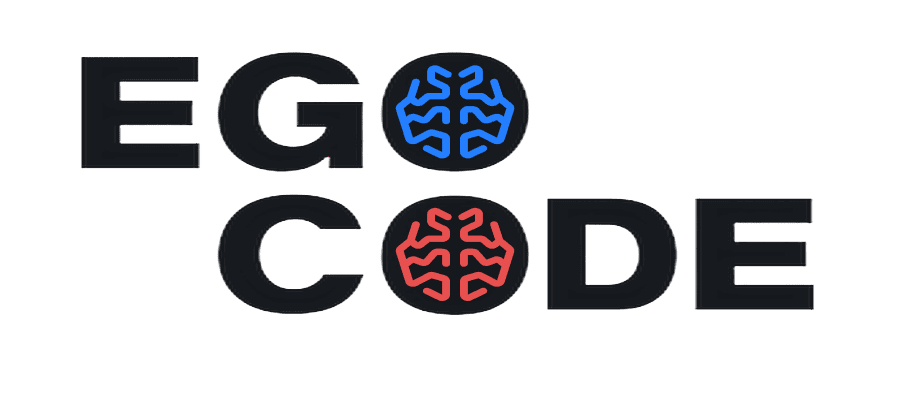


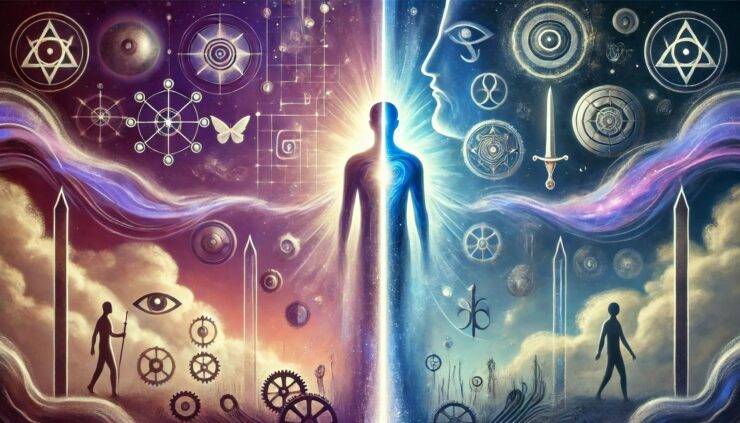
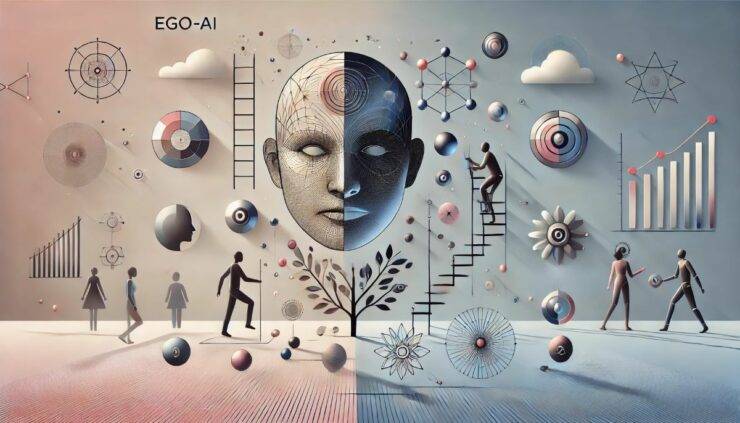
Wonderful beat ! I wish to apprentice while you amend your web site, how could i subscribe for a blog web site? The account aided me a acceptable deal. I had been a little bit acquainted of this your broadcast provided bright clear idea
It’s great that you came up with an idea! You can subscribe to updates on the website through the registration form